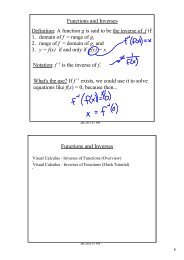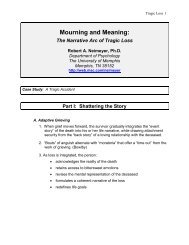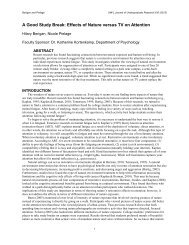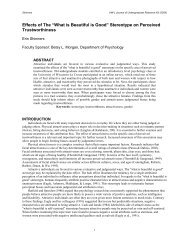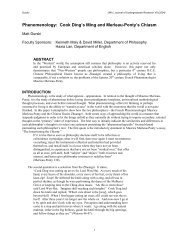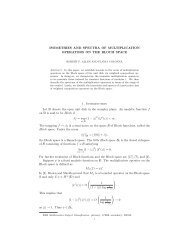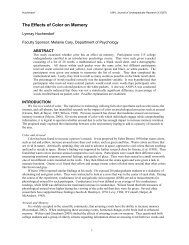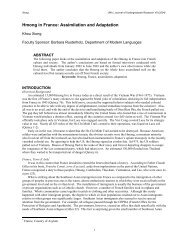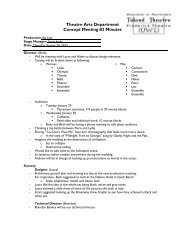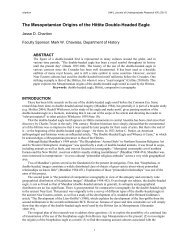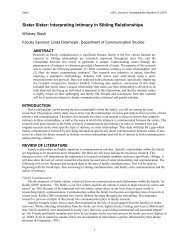Introduction to Management of Selected Women's Health ...
Introduction to Management of Selected Women's Health ...
Introduction to Management of Selected Women's Health ...
Create successful ePaper yourself
Turn your PDF publications into a flip-book with our unique Google optimized e-Paper software.
<strong>Introduction</strong> <strong>to</strong> <strong>Management</strong> <strong>of</strong> <strong>Selected</strong> Women’s <strong>Health</strong> MusculoskeletalDysfunction for the Outpatient Physical TherapistCourse DescriptionJill Schiff Boissonnault, PT, PhD, WCSThis one-day course will assist the out-patient orthopedic physical therapist and physical therapystudent in clinical decision making for management <strong>of</strong> selected musculoskeletal disorders inwomen’s health physical therapy. The focus will be <strong>to</strong> introduce those dysfunctions therapistswould likely encounter in the outpatient setting, describe first-line treatment strategies for thesedisorders as well as knowledge about when <strong>to</strong> refer <strong>to</strong> PT specialists or <strong>to</strong> primary care-givers.The course will be a mix <strong>of</strong> lecture and discussion with a limited amount <strong>of</strong> labora<strong>to</strong>ry practice.Disorders and dysfunctions covered will include osteoporosis, pelvic floor dysfunctions treatedin the OP ortho setting, obstetric pelvic girdle and low back pain, diastasis recti abdominis,postpartum coccydynia, common obstetric nerve entrapments and transient osteoporosis <strong>of</strong> thehip in pregnancy.Course ObjectivesAt the conclusion <strong>of</strong> this seminar, therapists will be able <strong>to</strong>:1. Define bone density conditions according <strong>to</strong> the WHO, be aware <strong>of</strong> commoninterventions for osteoporosis including appropriate exercise and manual therapyinterventions for this population.2. Differentiate between the types <strong>of</strong> urinary incontinence (UI) and <strong>to</strong> <strong>of</strong>fer basic pelvicfloor muscle exercises and behavioral strategies for UI and anal incontinence (AI).3. Screen for pelvic floor hyper<strong>to</strong>nous, coordination, neurogenic disorders and know when<strong>to</strong> refer these issues as well as when <strong>to</strong> refer patients for more advanced care <strong>of</strong> UI/AI.4. Understand systemic changes in the obstetric client and how symp<strong>to</strong>ms related <strong>to</strong> thesesystemic changes can mimic musculoskeletal dysfunction.5. Adapt his<strong>to</strong>ry-taking schema <strong>to</strong> the obstetric population and be aware <strong>of</strong> adaptationsnecessary <strong>to</strong> the physical exam <strong>of</strong> obstetric clients with musculoskeletal dysfunction.6. Develop plans <strong>of</strong> care for common musculoskeletal dysfunction in the obstetric client.Course Outline8:00-8:30 <strong>Introduction</strong>, objectives and overview <strong>of</strong> musculoskeletal dysfunction in women’shealth8:30-9:30 Osteoporosis principles for the out-patient ortho practitioner9:30-10:30 Pelvic Floor Dysfunction information for the out-patient ortho practitioner
10:30-10:45 Break10:45-12:00 Obstetric pathophysiology important <strong>to</strong> PT, by body system; with notes regardingscreening for referral <strong>to</strong> primary OB care-givers12:00-1:00 Lunch1:00-2:00 Physical therapy examination <strong>of</strong> the OB population with focus on musculoskeletaldysfunction: Patient-his<strong>to</strong>ry, adaptations <strong>to</strong> the physical examination2:00-3:30 Interventions for selected musculoskeletal dysfunction in OB (Rx for pelvic girdlepain, diastasis recti abdominis, oteoporosis in pregnancy, coccydynia, nerveentrapments)3:30-3:45 Break3:45-4:45 Interventions for selected musculoskeletal dysfunction in OB (Rx for pelvic girdlepain, diastasis recti abdominis, oteoporosis in pregnancy, coccydynia, nerveentrapments)-Continued4:45-5:00 Wrap-Up (including mention <strong>of</strong> what was not covered <strong>to</strong>day)BIODr. Jill Boissonnault, PT PhD WCS, holds a B.S. in Physical Therapy (University <strong>of</strong> Illinois), a Masters inOrthopedic Physical Therapy (Northwestern University), and a PhD (University <strong>of</strong> Wisconsin, Madison),in Curriculum and Instruction, minor in Women’s Studies. She has been treasurer <strong>of</strong> the OB/GYNSection (Now the Section on Women’s <strong>Health</strong>) <strong>of</strong> the APTA, Vice President and Education Direc<strong>to</strong>r andwas awarded the Section’s service award, the Elizabeth Noble Award, in 2000. In 2006 Dr. Boissonnaultreceived the WI PT Association Men<strong>to</strong>r award and the APTA’s Lucy Blair Service-Award. In 2011 she wasawarded a Service Award from the World Confederation for Physical Therapy (WCPT) and in 2012, aUW-Madison School <strong>of</strong> Medicine and Public <strong>Health</strong> Faculty and Staff Equity and Diversity Award. Shewas also named Northwestern University Physical Therapy Program’s Distinguished Alumnus <strong>of</strong> the yearfor 2013. She is immediate past President and Founder <strong>of</strong> the International Organization <strong>of</strong> PhysicalTherapists in Women’s <strong>Health</strong>, a sub-group <strong>of</strong> the WCPT. She has authored numerous pr<strong>of</strong>essionalarticles and textbook chapters in women’s health PT. Dr. Boissonnault is a Clinical Assistant Pr<strong>of</strong>essorand teaches Seminars in pr<strong>of</strong>essional issues and research, Service-learning, palpa<strong>to</strong>ry ana<strong>to</strong>my, andwomen’s health content throughout the curriculum at the University <strong>of</strong> Wisconsin-Madison PhysicalTherapy Program and is Direc<strong>to</strong>r <strong>of</strong> the UW-Hospitals and Clinics/Meriter Hospital Post-Pr<strong>of</strong>essionalResidency in Orthopedic Physical Therapy. She <strong>of</strong>fers seminars in ethics <strong>to</strong> meet licensure requirementson behalf <strong>of</strong> the program, consults in the area <strong>of</strong> women’s health PT and teaches continuing educationseminars on musculoskeletal management <strong>of</strong> the obstetric client.



